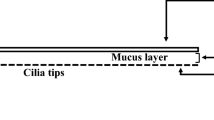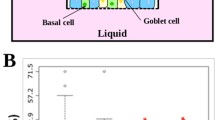Abstract
A new mathematical model of the transport of mucus and periciliary liquid (PCL) in the airways by cilia is presented. Mucus is represented by a linearly viscoelastic fluid, the mat of cilia is modelled as an ‘active porous medium.’ The propulsive effect of the cilia is modelled by a time-dependent force acting in a shear-thinned ‘traction layer’ between the mucus and the PCL. The effects of surface and interface tension are modelled by constraining the mucus free surface and mucus–PCL interface to be flat. It is assumed that the epithelium is impermeable to fluid. Using Fourier series, the system is converted into ODEs and solved numerically. We calculate values for mean mucus speed close to those observed by Matsui et~al. [{J. Clin. Invest.}, 102(6):1125’1131, 1998], (~40 μms−1). We obtain more detail regarding the dynamics of the flow and the nonlinear relationships between physical parameters in healthy and diseased states than in previously published models. Pressure gradients in the PCL caused by interface and surface tension are vital to ensuring efficient transport of mucus, and the role of the mucus–PCL interface appears to be to support such pressure gradients, ensuring efficient transport. Mean transport of PCL is found to be very small, consistent with previous analyses, providing insight into theories regarding the normal tonicity of PCL.
Similar content being viewed by others
References
Albers, G.M., Tomkiewicz, R.P., May, M.K., Ramirez, O.E., Rubin, B.K., 1996. Ring distraction technique for measuring surface tension of sputum: Relationship to sputum clearability. J. Appl. Physiol. 81(6), 2690–2695.
Barlow, E., 2000. Modelling muco-ciliary transport in the lung. Master’s thesis, School of Mathematics and Statistics, University of Birmingham.
Barton, C., Raynor, S., 1967. Analytical investigation of cilia induced mucous flow. Bull. Math. Biophys. 29, 419–428.
Blake, J.R., 1972. A model for the micro-structure in ciliated organisms. J. Fluid Mech. 55, 1–23.
Blake, J.R., 1973. Mucus flows. Math. Biosci. 17, 301–313.
Blake, J.R., 1975a. Fluid flow in fields of resistance. Bull. Aust. Math. Soc. 13, 129–145.
Blake, J.R., 1975b. On the movement of mucus in the lung. J. Biomech. 8, 179–190.
Blake, J.R., 1977. An active porous medium model for ciliary propulsion. J. Theor. Biol. 64, 697–701.
Blake, J.R., Gaffney, E.A., 2001. Modeling aspects of tracer transport in mucociliary flows. In: Salathe, M. (Ed.), Cilia and Mucus: From Development to Respiratory Defense. Dekker, New York, pp. 291–302.
Blake, J.R., Winet, H., 1980. On the mechanics of muco-ciliary transport. Biorheology 17, 125–134.
Boucher, R.C., 1994. Human airway ion transport. Part 1. Am. J. Respir. Crit. Care Med. 150, 271–281.
Boucher, R.C., 2003. Personal communication.
Boucher, R.C., Knowles, M.R., Yankaskas, J.R., 2000. Cystic fibrosis. In: Murray, J.F., Nadel, J.A. (Eds.), Textbook of Respiratory Medicine. Saunders, Philadelphia, PA, pp. 1291–1323.
Chwang, A.T., Wu, T.Y., 1975. Hydrodynamics of the low-Reynolds number flows. Part 2. The singularity method for Stokes flows. J. Fluid Mech. 67, 787–815.
Davis, S.S., Dippy, J.E., 1969. The rheological properties of sputum. Biorheology 6, 11–21.
Devalia, J.L., Sapsford, R.J., Rusznak, C., Toumbis, M.J., Davies, R.J., 1992. The effects of salmeterol and salbutamol on ciliary beat frequency of cultured human bronchial epithelial cells, in vitro. Pulm. Pharmacol. 5(4), 257–263.
Ekberg-Jansson, A., Larsson, S., Löfdahl, C.-G., 2001. Preventing exacerbation of chronic bronchitis and COPD. BMJ 322, 1259–1261.
Fulford, G.R., Blake, J.R., 1986. Muco-ciliary transport in the lung. J. Theor. Biol. 121, 381–402.
Fung, Y.C., 1993. Biomechanics, 2nd ed. Springer, New York.
Gibbs, B.F., Schmutzler, W., Vollrath, I.B., Brosthardt, P., Braam, U., Wolff, H.H., Zwadlo-Klarwasser, G., 1999. Ambroxol inhibits the release of histamine, leukotrienes and cytokines from human leukocytes and mast cells. Inflamm. Res. 48(2), 86–93.
Gueron, S., Liron, N., 1992. Ciliary motion modeling, and dynamic multicilia interactions. Biophys. J. 63, 1045–1058.
Guggino, W.B., 2001. Cystic fibrosis salt/fluid controversy: In the thick of it. Nat. Med. 7(8), 888–889.
Happel, J., 1959. Viscous flow relative to arrays of cylinders. AIChE J. 5(2), 174–177.
Hasani, A., Toms, N., O’Connor, J., Dilworth, J.P., Agnew, J.E., 2003. Effect of salmeterol xinafoate on lung mucociliary clearance in patients with asthma. Respir. Med. 94(6), 667–671.
International Commission on Radiological Protection and Measurements, 1994. Human respiratory tract model for radiological protection—ICRP Publication 66. Ann. ICRP 24, 1+.
Keller, S.R., 1975. Fluid mechanical investigations of ciliary propulsion. PhD thesis, California Institute of Technology.
Kerem, E., Bistritzer, T., Hanukoglu, A., Hofmann, T., Zhou, Z., Bennett, W., MacLaughlin, E., Barker, P., Nash, M., Quittell, L., Boucher, R., Knowles, M.R., 1999. Pulmonary epithelial sodium-channel dysfunction and excess airway liquid in pseudohypoaldosteronism. N. Engl. J. Med. 341, 156–162.
King, M., Agarwal, M., Shukla, J.B., 1993. A planar model for muco-ciliary transport: Effect of mucus viscoelasticity. Biorheology 30, 49–61.
Liron, N., Mochon, S., 1976. The discrete-cilia approach to propulsion of ciliated micro-organisms. J. Fluid Mech. 75, 593–607.
Liron, N., Rozenson, M., 1983. Muco-ciliary transport. J. Submicrosc. Cytol. 15(1), 317–321.
Lutz, R.J., Litt, M., Charkrin, L.W., 1973. Physical–chemical factors in mucus rheology. In: Gabelnick, H.L., Litt, M. (Eds.), Rheology of biological systems. Charles C. Thomas, Springfield, IL, pp. 119–157.
Matsui, H., Randell, S.H., Peretti, S.W., Davis, C.W., Boucher, R.C., 1998. Coordinated clearance of periciliary liquid and mucus from airway surfaces. J. Clin. Invest. 102(6), 1125–1131.
Meyer, F.A., Silberberg, A., 1980. The rheology and molecular organization of epithelial mucus. Biorheology 17, 163–168.
Pavia, D., Bateman, J.R., Lennard-Jones, A.M., Agnew, J.E., Clarke, S.W., 1986. Effect of selective and non-selective beta blockade on pulmonary function and tracheobronchial mucociliary clearance in healthy subjects. Thorax 41(4), 301–305.
Poole, P.J., Black, P.N., 2001. Oral mucolytic drugs for exacerbations of chronic obstructive pulmonary disease: Systematic review. BMJ 322, 1271–1274.
Puchelle, E., Herard, A.L., Zahm, J.M., 1998. Airway mucociliary epithelium injury and repair. In: Baum, G.L., Priel, Z., Roth, Y., Liron, N., Ostfeld, E.J. (Eds.), Cilia, Mucus, and Mucociliary Interactions. Dekker, New York, pp. 203–217.
Puchelle, E., Zahm, J.M., Quemada, D., 1987. Rheological properties controlling mucociliary frequency and respiratory mucus transport. Biorheology 24, 557–563.
Quemada, D., 1984. Towards a unified model of elasto-thixotropy of biofluids. Biorheology 21, 423–436.
Reid, L., 1973. Properties of mucus. Sci. Basis Med. Annu. Rev. 149, 130–150.
Rochat, T., Lacroix, J.S., Jornot, L., 2004. N-Acetylcysteine inhibits Na+ absorption across human nasal epithelial cells. J. Cell Physiol. 201(1), 106–116.
Rogers, D.F., 2004. Airway mucus hypersecretion in asthma: An undervalued pathology? Curr. Opin. Pharm. 4, 241–250.
Rogers, D.F., 2005. Mucociliary disfunction in COPD: Effect of current pharmacotherapeutic options. Pulm. Pharm. Ther. 18, 1–8.
Ross, S.M., 1971. A wavy wall analytic model of muco-ciliary pumping. PhD thesis, John Hopkins University.
Salathe, M., O’Riordan, T.G., Wanner, A., 1996. Treatment of muco-ciliary disfunction. Chest 110, 1048–1057.
Salathe, M., O’Riordan, T.G., Wanner, A., 1997. Mucociliary clearance. In: Crystal, R.G., West, P.J., Barnes, P.J., Weibel, E.R. (Eds.), The Lung: Scientific Foundations. Lippincott-Raven, Philadelphia, PA, pp. 2295–2308.
Sanderson, M.J., Sleigh, M.A., 1981. Ciliary activity of cultured rabbit tracheal epithelium: Beat pattern and metachrony. J. Cell Sci. 47, 331–341.
Shibuya, Y., Wills, P.J., Cole, P.J., 2003. Effect of osmolality on mucociliary transportability and rheology of cystic fibrosis and bronchiectasis sputum. Respirology 8(2), 181–185.
Silberberg, A., 1983. Biorheological matching: Mucociliary interaction and epithelial clearance. Biorheology 20, 215–222.
Sleigh, M.A., 1977. The nature and action of respiratory tract cilia. In: Brain, J.D., Proctor, D.F., Reid, L.M. (Eds.), Respiratory defense mechanisms Part I. Dekker, New York, pp. 247–288.
Sleigh, M.A., Blake, J.R., Liron, N., 1988. The propulsion of mucus by cilia. Am. Rev. Respir. Dis. 137, 726–741.
Smith, D.J. Modelling muco-ciliary transport in the lung Ph.D. Thesis University of Birmingham UK 2006.
Smith, D.J., Gaffney, E.A., Blake, J.R., 2006b. A model of tracer transport in airway surface liquid. Bull. Math. Biol., submitted for publication.
Smith, J.J., Travis, S.M., Greenberg, E.P., Welsh, M.J., 1996. Cystic fibrosis airway epithelia fail to kill bacteria because of abnormal airway surface liquid. Cell 85, 229–236.
Author information
Authors and Affiliations
Corresponding author
Additional information
An erratum to this article can be found at http://dx.doi.org/10.1007/s11538-006-9177-6
Rights and permissions
About this article
Cite this article
Lubkin, D.J., Gaffney, E.A. & Blake, J.R. A Viscoelastic Traction Layer Model of Muco-Ciliary Transport. Bull. Math. Biol. 69, 289–327 (2007). https://doi.org/10.1007/s11538-005-9036-x
Received:
Accepted:
Published:
Issue Date:
DOI: https://doi.org/10.1007/s11538-005-9036-x




